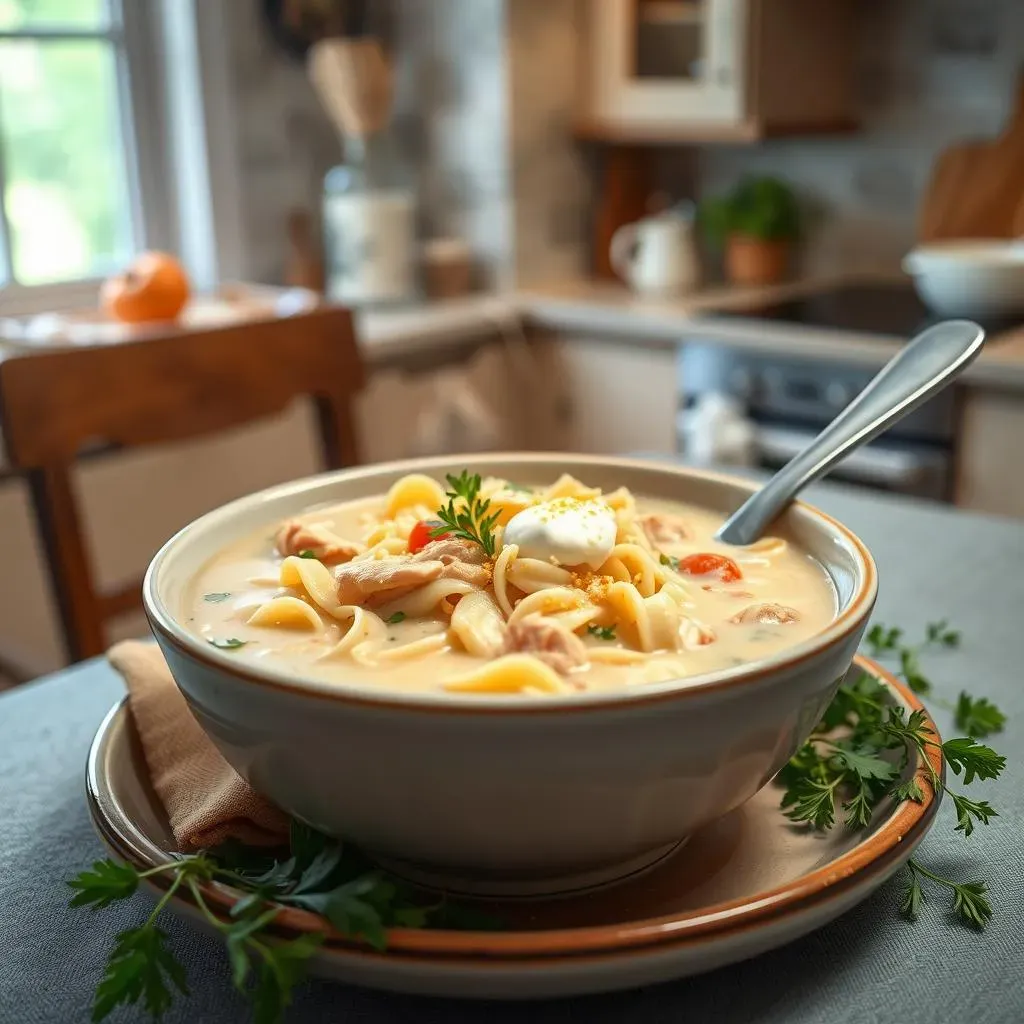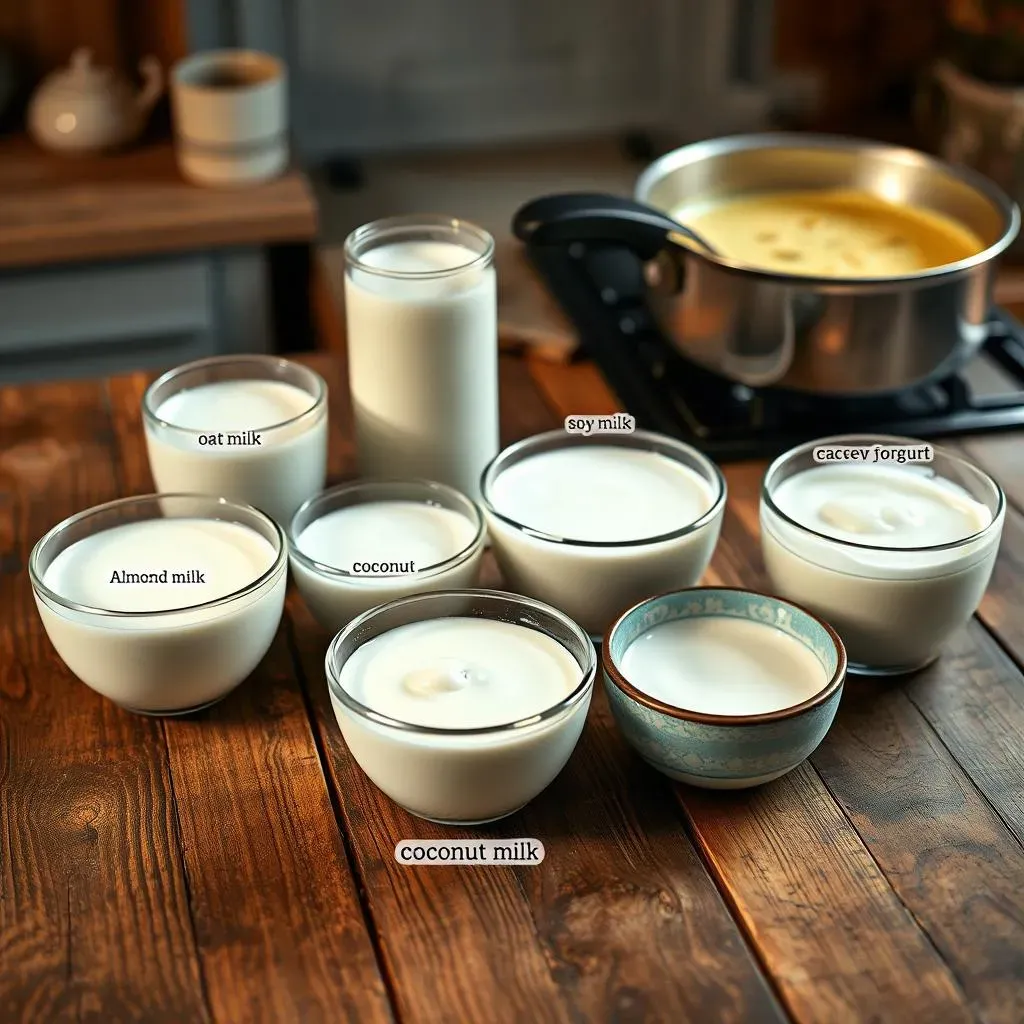Table of Contents
Ever craved a chicken noodle soup that’s rich, creamy, and satisfying? You're not alone! While classic chicken noodle soup is comforting, sometimes we yearn for that extra touch of indulgence. That's where dairy comes in, transforming a simple soup into a decadent meal. This article is your guide on how to add dairy to chicken noodle soup, unlocking a world of creamy goodness. We'll explore the best dairy options, from rich creams to tangy yogurts, and how each can elevate your soup. We'll also tackle thickening methods, because nobody likes a watery soup. Plus, if you're dairy-free, don't worry! We'll cover tasty alternatives too. Get ready to ditch the broth and embrace a world of creamy, dreamy chicken noodle soup. We'll walk through each step, ensuring you create the most delicious bowl of soup imaginable. So, grab your ladle and let’s get started!
Why You'll Love This Creamy Chicken Noodle Soup

Why You'll Love This Creamy Chicken Noodle Soup
Comfort in a Bowl
Let's be real, sometimes you just need a hug in a bowl. That's exactly what this creamy chicken noodle soup is. It's not your grandma's thin, watery broth (sorry, Grandma!). We're talking about a rich, velvety texture that coats your spoon and warms you from the inside out. The combination of tender chicken, soft noodles, and that creamy base makes it the ultimate comfort food. It's perfect for chilly nights, sick days, or just when you need a little bit of self-care.
Plus, it's incredibly versatile. You can customize it with your favorite veggies, herbs, or even a squeeze of lemon for a touch of brightness. And did I mention it's super easy to make? Seriously, even if you're a kitchen newbie, you can nail this recipe. It’s the kind of meal that makes you feel good, both while you’re eating it and after. Forget the bland, boring soups, this one's a flavor explosion in every spoonful.
Benefit | Description |
|---|---|
Comforting | Provides a warm, satisfying feeling. |
Versatile | Easily customizable with different ingredients. |
Easy to Make | Simple recipe suitable for all skill levels. |
Delicious | Flavorful and enjoyable to eat. |
A Flavor Upgrade
Okay, so we’ve established it’s comforting, but it's also a major flavor upgrade from the traditional version. The dairy adds a depth of flavor that you just can't get from broth alone. It's not just about being creamy; it's about creating a richer, more complex taste. The subtle tang of sour cream or the slight sweetness of milk can really enhance the overall profile of the soup. It's like adding a secret ingredient that takes it from good to amazing.
Think about it: a simple chicken noodle soup is nice, but a creamy chicken noodle soup? That's a whole different ball game. It’s the kind of meal that feels like a treat, even though it’s packed with wholesome ingredients. It’s also a great way to sneak in some extra veggies for those picky eaters. And trust me, once you try it this way, you'll never go back to the plain old stuff. It's just too darn good!
Best Dairy Ingredients to Elevate Your Chicken Noodle Soup

Best Dairy Ingredients to Elevate Your Chicken Noodle Soup
Creamy Dream: Milk and Half-and-Half
Okay, let's talk about the classics first. When you think of creamy soup, milk and half-and-half are probably the first things that come to mind, and for good reason. Whole milk adds a nice, subtle creaminess, making your soup feel richer without being too heavy. It’s a great option if you want a lighter touch of dairy. Half-and-half, on the other hand, takes things up a notch. It's thicker and creamier than milk, giving your soup a more luxurious texture. It's that middle ground between milk and heavy cream, perfect for when you want a bit more indulgence but aren't ready for the full-on richness of heavy cream. When you add them, make sure your soup is not boiling, this will prevent curdling.
I've found that adding the dairy at the end, after you turn off the heat, is the best way to avoid any unwanted separation. Stir it in gently until it's fully incorporated. It's like adding a silky smooth blanket to your soup. Remember, don't boil it after adding the dairy, or it might curdle, which is a total buzzkill. And if you are feeling fancy you can even use a combination of both.
Tangy Twists: Sour Cream and Yogurt
Now, let's get a little adventurous! If you're looking for a creamy soup with a bit of a tangy kick, sour cream and yogurt are your secret weapons. Sour cream adds a wonderful richness and a slight tang that cuts through the heaviness of the soup. It's like adding a little bit of a surprise to every spoonful. Yogurt, especially Greek yogurt, can also bring a similar tang and creaminess, but it's a bit lighter than sour cream. It's a great option if you want a creamy texture without the extra richness.
Just like with milk and half-and-half, it's best to stir in sour cream or yogurt at the very end, off the heat. This prevents them from curdling and keeps that velvety texture intact. I once added sour cream to a boiling soup ( don't ask why ) and it was a disaster. The soup looked like it had tiny little white clumps floating around. So, learn from my mistakes, and add them gently when the soup is not boiling! A little goes a long way, so start with a small spoonful and add more to your liking. It’s like a flavor explosion in your mouth!
Dairy Ingredient | Texture | Flavor | Best Use |
|---|---|---|---|
Whole Milk | Lightly creamy | Mildly sweet | For a lighter, subtle creaminess |
Half-and-Half | Creamy | Slightly sweet | For a richer texture than milk |
Sour Cream | Rich and thick | Tangy | For a creamy, tangy kick |
Greek Yogurt | Thick | Tangy, slightly tart | For a lighter creamy, tangy option |
How to Add Dairy to Chicken Noodle Soup: StepbyStep

How to Add Dairy to Chicken Noodle Soup: StepbyStep
Prep Your Soup Base
Alright, let's get down to business! Before you even think about adding that creamy goodness, make sure your soup is just about ready. This means your chicken is cooked, your noodles are tender, and your veggies are all soft. You want everything to be at the perfect stage before you introduce the dairy. Think of it like prepping a canvas before you paint. You wouldn't just start throwing paint on a blank canvas, would you? Same goes for soup. If you are using raw chicken, make sure to cook it all the way through, no one wants a salmonella surprise in their soup.
Also, make sure that your soup is not boiling hot, you do not want to curdle your milk or sour cream, it is very important to lower the temperature of the soup before you add the dairy. This will prevent any weird textures or separation. Trust me, a little prep goes a long way in making sure your soup is as creamy and dreamy as possible. You can also take out a little bit of the broth and let it cool down, before adding it back into the soup. This will lower the temperature of the overall soup.
The Gentle Stir-In
Now, for the main event: adding the dairy. The key here is to be gentle. Don't just dump it in like you're pouring concrete. You want to stir it in slowly and carefully. Turn off the heat completely, and let the soup cool down for a few minutes. Slowly pour in your chosen dairy, whether it's milk, half-and-half, sour cream, or yogurt. Stir it in gently, making sure it's fully incorporated. Don't over-stir, just make sure it's all mixed in evenly.
Think of it like you are mixing in delicate ingredients, they need to be treated with care. The goal here is to create a smooth and velvety texture, not a lumpy mess. If you are using sour cream or yogurt, you can add a spoonful at a time. Taste as you go and add more to your liking. Remember, the dairy will continue to thicken the soup, so don’t overdo it in the first go. It's like a dance, you need to move slowly and gently.
Step | Action | Why |
|---|---|---|
1 | Prepare Soup Base | Ensures all ingredients are cooked and ready. |
2 | Turn Off Heat | Prevents dairy from curdling. |
3 | Add Dairy Slowly | Ensures even distribution and smooth texture. |
4 | Stir Gently | Incorporates dairy without over-mixing. |
Taste and Adjust
Alright, your soup is now creamy and dreamy, but it's not quite finished. This is where you taste and adjust. Take a spoonful, and see what you think. Does it need more dairy? Maybe a little more salt or pepper? This is your time to make it perfect. If you like it even creamier, go ahead and add a bit more dairy. If it's too thick, add a touch of broth or water to thin it out. This is your soup, so make it your way. This is the part where you get to be the chef, so have fun with it.
Remember, cooking is an art, not a science, so don't be afraid to experiment. If you want a little extra tang, add a squeeze of lemon juice. If you want a little heat, add a pinch of red pepper flakes. The possibilities are endless. It’s like you are adding your personal signature to the soup. And don't forget to serve it up hot with a side of crusty bread or crackers. It’s the perfect ending to a delicious process.
Thickening Your Soup with Dairy and Other Methods

Thickening Your Soup with Dairy and Other Methods
Dairy as a Thickener
Okay, so we've talked about adding dairy for flavor, but it's also a fantastic way to thicken your soup. The fat content in milk, half-and-half, and especially cream, helps to create a richer, more substantial texture. It's like adding a built-in thickener that also makes your soup taste amazing. When you add dairy, it doesn't just make your soup creamy; it also helps to bind everything together, creating a more cohesive and satisfying bowl. It's like a culinary two-for-one deal. But here's the thing, dairy alone might not be enough for the super thick soup you are dreaming of.
If you are going for a really thick consistency, you might need to use a little help. That's where other thickening agents come in. I've found that a combination of dairy and another thickener works best. It's like having a dynamic duo that ensures your soup is perfectly thick and flavorful. You can play around with different combinations to find your perfect consistency. I once tried using only dairy to thicken a huge batch of soup, and let's just say it took forever to get it to the right thickness. So, don't be afraid to explore other options.
Thickening Method | Description | Best For |
|---|---|---|
Dairy (Milk, Cream) | Adds creaminess and some thickness | Subtle thickening |
Roux (Flour and Butter) | Creates a stable and thick base | Significant thickening |
Cornstarch Slurry | Quickly thickens liquids | Emergency thickening |
Mashed Potatoes | Adds starch and creaminess | Hearty thickening |
Other Thickening Methods: Roux, Cornstarch, and More
Alright, let’s talk about some other tools in your thickening arsenal. First up is the classic roux, which is basically a mixture of fat (usually butter) and flour. You cook them together until they form a paste, and then you whisk it into your soup. This is a great way to create a super thick and stable base for your soup. It's like building a solid foundation for your creamy masterpiece. I know it sounds fancy, but it's actually quite easy to do. Just make sure to cook it for a bit so it doesn't taste like raw flour.
Then there's the cornstarch slurry, which is basically a mix of cornstarch and cold water. You whisk it together and then add it to your soup. It's like a quick fix for when you need to thicken your soup in a hurry. It works like a charm, you just have to be careful not to add too much, or you'll end up with a gloopy mess. And last but not least, mashed potatoes. Yes, you heard me right! Adding mashed potatoes to your soup not only adds a creamy texture but also makes it extra hearty. It's like a secret weapon for making your soup extra satisfying. It's also a great way to use up leftovers! So, don't be afraid to experiment with these different methods.
Can I Use DairyFree Alternatives?

Can I Use DairyFree Alternatives?
Plant-Based Power: Milk Alternatives
So, what if you're not a fan of dairy or you can't have it? No problem! The good news is, there are tons of amazing dairy-free alternatives that can still make your chicken noodle soup super creamy. We're talking about plant-based milks like almond milk, soy milk, oat milk, and even coconut milk. Each one has its own unique flavor and texture, so you can pick the one that best suits your taste. Almond milk is pretty light and has a slightly nutty flavor, while soy milk is a bit richer and creamier. Oat milk is a popular choice for its creamy texture and neutral taste, and coconut milk adds a hint of sweetness and richness. Experiment a bit and see which one you like best. It's like having a whole new world of creamy possibilities at your fingertips.
I've tried them all, and honestly, they all work great. Just remember that some might be a bit thinner than dairy milk, so you might need to use a bit more to get the same level of creaminess. Also, if you are using coconut milk, be aware that the flavor will be more present in the soup. I once used coconut milk in my soup, and while it was delicious, it had a very distinct coconut flavor, which might not be for everyone. So, choose wisely and have fun with it! It's all about finding what works best for you. The beauty of cooking is that you can always try new things and adapt to your preferences.
Dairy-Free Alternative | Texture | Flavor | Best Use |
|---|---|---|---|
Almond Milk | Light | Slightly nutty | For a lighter, subtle creaminess |
Soy Milk | Creamy | Mild, slightly beany | For a richer texture than almond milk |
Oat Milk | Smooth, creamy | Neutral, slightly sweet | For a creamy texture with neutral taste |
Coconut Milk | Rich, thick | Sweet, coconutty | For a very rich and sweet flavor profile |
Creamy Alternatives: Plant-Based Sour Cream and Yogurt
And it doesn’t stop there! Just like with milk, there are also amazing dairy-free alternatives for sour cream and yogurt. You can find plant-based sour cream made from things like cashews or soy, which have a similar tangy flavor and creamy texture. And for yogurt, there are so many options out there, from coconut yogurt to almond yogurt to soy yogurt. They all add a lovely tang and creaminess to your soup, just like their dairy counterparts. It's like a magic trick, you get all the creamy goodness without any of the dairy. And the best part is, they are usually very easy to find in most grocery stores.
The same rules apply when using plant-based alternatives: add them at the end, off the heat, to prevent any curdling or separation. I once made a soup with cashew sour cream, and it was so delicious, I couldn’t tell the difference from the real thing! So, don’t feel like you are missing out on anything just because you are not using dairy. The world of plant-based alternatives is vast and exciting, and it’s constantly evolving. You can find a substitute for pretty much any dairy product these days! It’s a great way to make your soup more inclusive for anyone with dietary restrictions. And honestly, it’s just fun to experiment with new ingredients and flavors.
Serving and Storing Your DairyRich Chicken Noodle Soup

Serving and Storing Your DairyRich Chicken Noodle Soup
Serving Suggestions: Making it a Meal
Okay, you've made this amazing, creamy chicken noodle soup, now what? Well, let's talk about serving it up right! First off, make sure it's nice and hot. There's nothing worse than a lukewarm bowl of soup, right? Ladle it into your favorite bowls, and if you're feeling fancy, garnish it with a sprinkle of fresh parsley or a dollop of extra sour cream. It's all about the presentation! But seriously, the taste is what really matters here, so make sure it's seasoned just how you like it.
Now, for the sides. A crusty piece of bread or some crackers are always a great addition. They're perfect for soaking up all that delicious broth. You can also add a side salad for a little extra freshness. And, if you're feeling extra adventurous, you can even serve it in a bread bowl! It's like a soup and bread combo in one. I once went to a restaurant that served soup in a bread bowl, and I was hooked. It was like a culinary hug. So, don't be afraid to get creative and make your soup serving an experience!
Storing for Later: Keeping it Fresh
So, you've made a big batch of this creamy goodness, and you have leftovers. No worries! This soup actually stores quite well, as long as you follow a few simple rules. First, let it cool down completely before you put it in the fridge. This prevents condensation from forming and making your soup watery. Once it's cooled, transfer it to an airtight container. This will help keep it fresh and prevent any weird fridge odors from getting in.
The soup can be stored in the fridge for about 3-4 days, but I've found that it tastes best within the first 2 days. If you want to keep it for longer, you can also freeze it. Just make sure to use a freezer-safe container and leave a little bit of space at the top for expansion. When you are ready to eat it, thaw it out in the fridge overnight, and then reheat it on the stovetop. Just be aware that the texture might change a bit after freezing. It might not be as creamy as it was when it was fresh, but it will still taste delicious. So, don't be afraid to make a big batch and enjoy it later!
Storage Method | Time | Notes |
|---|---|---|
Refrigerator | 3-4 days | Store in airtight container. |
Freezer | Up to 3 months | Use freezer-safe container, leave space for expansion. |
Reheating Tips: Bringing it Back to Life
Alright, you've stored your soup, and now it's time to reheat it. The best way to do this is on the stovetop. Pour the soup into a pot and heat it over medium heat, stirring occasionally. You want to make sure it heats up evenly and doesn't burn on the bottom. Once it's simmering, it's ready to go! If you are in a rush, you can also reheat it in the microwave, but be careful not to overheat it. It's all about being gentle and patient.
Also, remember that the texture might be a little different after reheating, especially if it has been frozen. If it seems a little too thick, you can add a little bit of broth or water to thin it out. And if it's not as creamy as you'd like, you can always add a little extra milk or cream. It's like giving your soup a little makeover. The most important thing is to make sure it's hot and delicious before you serve it. So, don't be afraid to experiment and adjust to your liking. It's your soup, after all!
